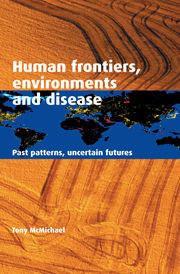Book contents
- Frontmatter
- Contents
- List of sources for illustrations
- Preface
- 1 Disease patterns in human biohistory
- 2 Human biology: the Pleistocene inheritance
- 3 Adapting to diversity: climate, food and infection
- 4 Infectious disease: humans and microbes coevolving
- 5 The Third Horseman: food, farming and famines
- 6 The industrial era: the Fifth Horseman?
- 7 Longer lives and lower birth rates
- 8 Modern affluence: lands of milk and honey
- 9 Cities, social environments and synapses
- 10 Global environmental change: overstepping limits
- 11 Health and disease: an ecological perspective
- 12 Footprints to the future: treading less heavily
- Notes
- Index
9 - Cities, social environments and synapses
Published online by Cambridge University Press: 05 March 2012
- Frontmatter
- Contents
- List of sources for illustrations
- Preface
- 1 Disease patterns in human biohistory
- 2 Human biology: the Pleistocene inheritance
- 3 Adapting to diversity: climate, food and infection
- 4 Infectious disease: humans and microbes coevolving
- 5 The Third Horseman: food, farming and famines
- 6 The industrial era: the Fifth Horseman?
- 7 Longer lives and lower birth rates
- 8 Modern affluence: lands of milk and honey
- 9 Cities, social environments and synapses
- 10 Global environmental change: overstepping limits
- 11 Health and disease: an ecological perspective
- 12 Footprints to the future: treading less heavily
- Notes
- Index
Summary
If we still believe that cities are the most complicated artifact we have created, if we believe further that they are cumulative, generational artifacts that harbor our values as a community and provide us with the setting where we can learn to live together, then it is our collective responsibility to guide their design.
Kostoff S, 1991Towns and cities are at the heart of human history. Even so, they are a relatively recent product of cultural evolution, and a radical transformation of the human habitat. As urbanisation gathers momentum around the world, the urban environment increasingly dominates the landscape of human social interactions and physical exposures. Life in cities presents a complex profile of gains and losses for human health.
Settled living first occurred in the Fertile Crescent of the Middle East as early agrarianism emerged. The consequences for infectious diseases and nutritional disorders have been explored in chapters 4 and 5. Equally importantly, the advent of settled agrarian living transformed humankind's social and economic relations, resulting particularly in the concept of ‘property’ – occupied farm-land, permanent dwellings, and a local market for exchanging surplus products. As rural settlements grew into larger villages, the increasing productivity of the land allowed the development of social stratification. As Charles Darwin remarked in his journal, commenting on the equality that he observed in the primitive inhabitants of Tierra del Fuego during his voyage on the Beagle:
- Type
- Chapter
- Information
- Human Frontiers, Environments and DiseasePast Patterns, Uncertain Futures, pp. 250 - 282Publisher: Cambridge University PressPrint publication year: 2001



